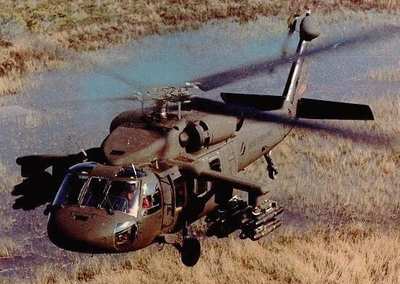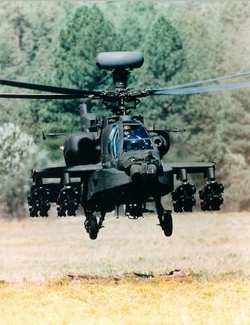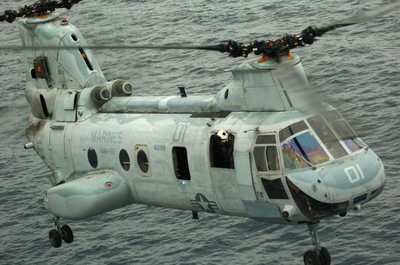Adds Recent Sea Knight Downing May Be Due To Mechanical
Failure
A top US military official in Iraq states despite a rash of
recent downings of US helicopters to enemy ground fire, air travel
is still the safest way to transport troops and supplies in the
embattled country. Army Maj. Gen. James E. Simmons, deputy
commanding general for support for Multinational Corps Iraq,
acknowledged six helicopters have either been shot down or crashed
since January 20.

In the past three weeks, two Army UH-60 Black Hawks and two
AH-64 Apaches have been shot down, killing 16 soldiers. As ANN reported, a Marine
CH-46 Sea Knight went down outside Baghdad February 7, killing all
seven Marines onboard. Initial reports indicated ground fire
may have been responsible for that crash, as well... but in a
Sunday briefing, Simmons said early reports point
to mechanical failure as the cause of the downing.
 Also, two civilian helicopters have
crashed in eastern Baghdad, one killing five private security
company employees, according to reports. No casualties were
reported in the second crash.
Also, two civilian helicopters have
crashed in eastern Baghdad, one killing five private security
company employees, according to reports. No casualties were
reported in the second crash.
Officials believe two of the Army incidents
were linked, the general said. Both times, insurgents set up
explosive devices along the routes most likely to be used by the
deploying coalition quick-reaction force, he explained.
Simmons discounted reports advanced missile systems are being
used to shoot down helicopters in Iraq, citing a lack of evidence
to back those claims up. He also said there is no evidence that a
specific group has been targeting the aircraft -- but he did
acknowledge insurgents are adapting, their tactics have evolved,
and Army air missions have increased.
"We are engaged with a thinking enemy. This enemy understands
... that we are in the process of executing the prime minister's
new plan for the security of Baghdad. And they understand the
strategic implications of shooting down an aircraft," Simmons said.
"It is in their interests, from a strategic perspective, to attempt
to engage and shoot down our aircraft."
Army helicopters average 100 enemy firefights monthly, and are
hit about 17 times a month. Most times the helicopters are able to
fly back to base. Simmons said that is a testament to the quality
of pilots, crews and equipment.
The number of flight hours for the Army has nearly doubled in
the past two years. In 2005, pilots logged about 240,000 hours.
This year, Simmons said, he expects that number to reach nearly
400,000 hours. In 2006, pilots and crews flew 334,000 hours.
The Army has lost 29 helicopters to enemy fire since March 2003,
Simmons said. The majority of the firefights involve machine-gun
and heavy-machine-gun fire, categorized as up to 23 mm, Simmons
said. But, he added, some surface-to-air missiles, such as SA-7s,
SA-14s and SA-16s, have been used to shoot down Army
helicopters.
Investigations are ongoing in the incidents, but meanwhile it is
business as usual for Army aviators in Iraq, Simmons said.
"We have not cancelled one mission, and there has been
absolutely no reduction in rotary-wing aircraft flight -- nor will
there be," Simmons said. "We have reviewed our procedures, and we
have made modifications as to how and where and when we're flying,
and we will do that periodically."
Simmons, himself an Army master aviator, said he is a passenger
on an Army helicopter almost daily.

"I can't tell you how proud I am of the young men and women who
are operating these machines. They're incredible talented. They're
incredibly bright. They're incredibly courageous," he said.
"We will continue to fly. It is the safest way that I know of to
get around here in Iraq. And we will continue to do it and I will
continue to be proud to fly with them."
(ANN thanks Fred W. Baker III, American Forces Press
Service)
 ANN's Daily Aero-Term (04.25.24): Airport Rotating Beacon
ANN's Daily Aero-Term (04.25.24): Airport Rotating Beacon ANN's Daily Aero-Linx (04.25.24)
ANN's Daily Aero-Linx (04.25.24) Klyde Morris (04.22.24)
Klyde Morris (04.22.24) Airborne 04.24.24: INTEGRAL E, Elixir USA, M700 RVSM
Airborne 04.24.24: INTEGRAL E, Elixir USA, M700 RVSM Airborne 04.22.24: Rotor X Worsens, Airport Fees 4 FNB?, USMC Drone Pilot
Airborne 04.22.24: Rotor X Worsens, Airport Fees 4 FNB?, USMC Drone Pilot





